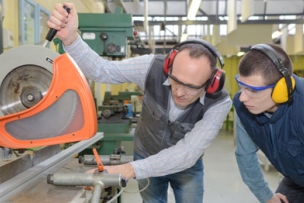Spring Cleaning: Equipment and Facility Maintenance Can Lift Safety Culture
Getting employees invested in spring maintenance tasks can improve the effectiveness of this proactive approach.
In springtime, you may clean your home’s windows, check the batteries in your smoke detectors and make outside repairs that were too challenging during the winter months. Just like the places where we live, the places where we work may need some extra attention as the weather warms up. See the pointers included here to help make your own checklist.
Gregory Margison, a safety specialist for MSC, says formal spring maintenance programs aren’t common at manufacturing facilities, but they’re a good, proactive approach that can help address a variety of safety issues.
“People need to be a lot more proactive,” Margison says. “Dust and dirt and grime can lead to a lot of different hazards.”
Where to Start: Spring Facility Maintenance
Some plants will plan a summer shutdown to address maintenance issues. Margison says the difference with spring maintenance programs is that spring maintenance is done when a facility is fully staffed, whereas during a summer shutdown, many workers may be sent home. “So there are only a small percentage of employees that are usually on-site” for shutdowns, he says.
“From a safety aspect, if you do spring cleaning, you can involve a lot more employees,” he notes. “You can delegate tasks to different employees and give them that sense of ownership and an understanding of how important their task is to the safety program. And I think by doing that you enrich the safety culture.”
Margison says getting buy-in from all employees usually starts with a facility safety manager. The safety manager may need to work with supervisors and plant managers. He recommends that safety managers look at specific areas and identify safety hazards, then delegate a task to the person or people who work in that area.
What to Put on Your Spring Maintenance Checklist
Margison says indoor and outdoor areas both need to be checked for maintenance issues in the spring. There are many tasks he suggested manufacturing facilities should include in this process.
Fall Protection Inspection
Inspect harnesses and anchor points on fall protection equipment to make sure it’s still safe, as well as checking any rescue equipment for confined spaces.
Check for slip, trip and fall hazards: Make sure aisles and walkways are free of clutter and meet the OSHA standard (1910.22 Walking-Working Surfaces) for “clean, orderly, and sanitary conditions.” Margison also recommends making sure tools are kept in a centralized location and that ladders are stored in assigned spots instead of left in work areas.
Gas Detection, Chemical Management, Fire Safety
Make sure gas detection is calibrated for your confined spaces.
Look for chemicals that are not labeled properly or are left in work areas, including aerosol cans and other substances that should be stored in a fireproof cabinet.
Test fire extinguishers, sprinklers and alarm systems.=
Emergency Management, First Aid, Signage
Look over emergency management plans to prepare for inclement spring weather like tornadoes and floods. This includes making sure any shelters are clearly marked.
Inspect first-aid boxes to make sure they’re fully stocked and that supplies haven’t passed their expiration date.
Check on signage.
“The weather can be pretty rough,” says Margison. Signs may be faded or missing due to wind, snow, rain or sun exposure. This can also include checking on interior signage around hazards, or signs detailing lockout/tagout procedures for specific machines.
Go deeper on emergency planning and disaster recovery. Read “Emergency Preparedness Training: Tabletop Exercises vs. Mock Drills.”
Traffic Safety, Cleaning
Check spot mirrors and other traffic safety devices to make sure they’re still positioned correctly.
Do some dusting.
“When I think of spring cleaning at home, I think you’ve got a lot of dust, you’ve got to clean up,” says Margison. “Well, dust in an industrial setting can pose a significant explosion hazard.”
He said the preferred method of cleanup is vacuuming, but facilities can also sweep or wipe things down.
Get Employee Buy-In on Spring Facility Maintenance
Making safety everyone’s responsibility means getting employees invested in safety processes like spring cleaning. Margison recommends facilities make safety as personal as possible, and find interesting ways to engage employees in safety discussions.
“I see a lot of people that have health and safety fairs on-site, and they get people really jazzed up and excited about safety,” he says, noting that the events would make a good kickoff for a week or month focused on spring maintenance tasks. “Get everyone’s attention, make it fun. And then delegate those tasks and let them feel like they’re participating and really making a difference in the facility.”
“Everybody can have a task,” Margison says. “Safety is everyone’s priority, or should be everyone’s priority, at any facility. So anybody can contribute, from the janitor to the facility manager. …If you give someone that sense of ownership, you will get buy-in.”
How do you get employees invested in plant maintenance?



.jpg?itok=noeLdLkx)

Talk to Us!
Do you actually do spring cleaning or just provide tips.
24Leave a reply
Your email address will not be published. Required fields are marked *